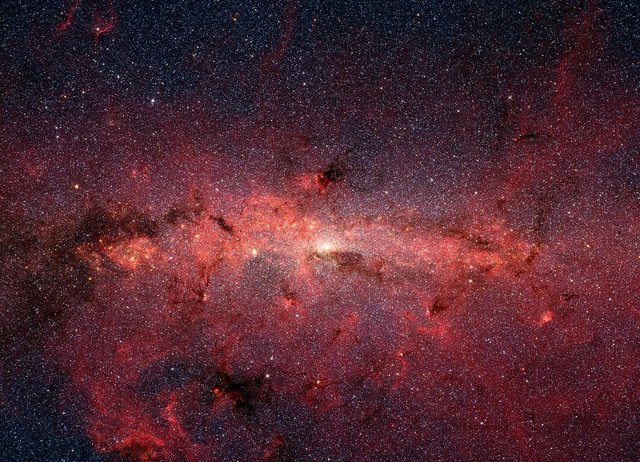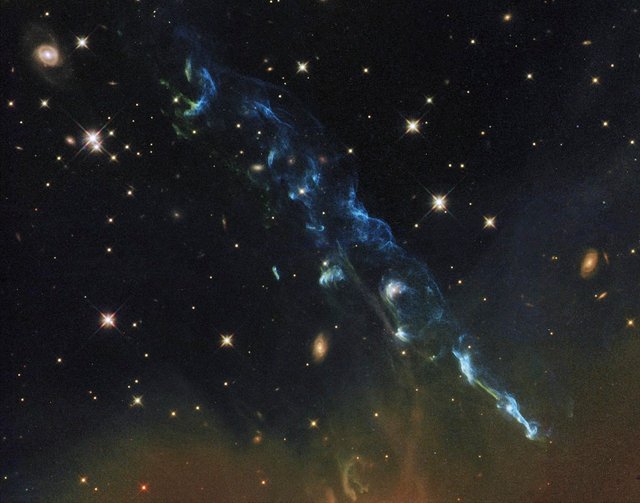The Milky Way

Image source [1]: The Milky Way's Galactic Center in the night sky above the Paranal Observatory (the laser creates a guide-star for the telescope).
Hello friends, continuing our journey through the universe today we are going to talk about the Milky Way. The Milky Way is the galaxy that contains our Solar System. The descriptive "milky" is derived from the appearance of Earth of the galaxy a band of light seen in the night sky formed from stars that can not be distinguished by the naked eye.
The most important characteristics of our galaxy, the Milky Way, is highlighted in the material A13. With respect to the study in other galaxies we have the advantage that we observe the stars individually, that is, we observe the particles of the star fluid. But we have the disadvantage that we do not appreciate the overall vision. Unlike in other galaxies, we observe the micro state but not the macro state. When observing in visible, the dust prevents us from seeing far. When we observe (radio), we see everything, but all at once, which is also a problem because, in principle, we can not distinguish what is far from what is near. The distribution of stars can be obtained directly, since we see them and in principle, we know their distance. It is true that we can only obtain it in the vicinity of the sun.
The Milky Way contains between 200 and 400 billion stars and at least 100 billion planets. The exact figure depends on the number of very-low-mass stars, which are hard to detect, especially at distances of more than 300 l (90 pc) from the Sun. As a comparison, the neighboring Andromeda Galaxy contains an estimated one trillion (1012) stars. Filling the space between the stars is a disk of gas and dust called the interstellar medium.

Image source [2]: Spitzer reveals what cannot be seen in visible light: cooler stars (blue), heated dust (reddish hue), and Sgr A* as bright white spot in the middle.

Image source [3]: Illustration of the two gigantic X-ray/gamma-ray bubbles (blue-violet) of the Milky Way (center).
A stellar collision is the coming of two stars caused by gravity, gravitational radiation, and other mechanisms not well understood. Astronomers predict that events of this type occur in the globular clusters of our galaxy about once every 10,000 years. In 2008 scientists first observed a stellar merger in Scorpius, though it was not known to be the result of a stellar merger at the time.
Collisions between stars are not very frequent. We are not referring to frontal clashes between stars, but to serious interactions between them that significantly alter their trajectory.
Massachusetts Institute of Technology (MIT)
In astronomy, the interstellar medium (ISM) is the matter and radiation that exists in the space between the star systems in a galaxy. This matter includes gas in ionic, atomic, and molecular form, as well as dust and cosmic rays. It fills interstellar space and blends smoothly into the surrounding intergalactic space.
Although in a galaxy like ours, gas is "today" a minority component, of only 10% of the visible mass, its importance in evolution and galactic dynamics is great. Gas was born and the stars are still born. One of our goals is precisely the birth of the stars. But in addition, forces appear on the gas that do not act on the stars, such as the magnetic, and as the viscosity.

Image source [4]: Herbig–Haro 110 object ejects gas through interstellar space.

Image source [5]: This light-year-long knot of interstellar gas and dust resembles a caterpillar.
The birth of the stars
Stars are born where the gas density is higher. Essentially, the process is that of gravitational collapse: the closer the atoms of a pro-stellar gas cloud are.
Science Channel

Each day i look forward to always learn from your post. And in a short while, have been able to see the beauty the universe possessed. Thank you for always sharing with us.
Being a student of Biology, It's something really unbelievable for me. 100 Billion planets and 200-400 starts??? That's just toooooo much
That was my impression in my student days when I started studying this area of physics, and I'm still learning new things
Universe is full of wonders
This is really amazing session, thanks for sharing this informative and knowledge sharing post.
Stay Blessed.
Thanks friend :D
Welcome. 🙂
posstingan nice, i've upvote you, do not forget my upvote @azhariari